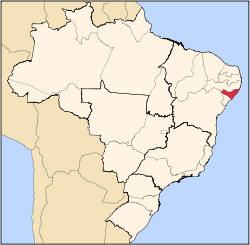Palmares (quilombo)
| Quilombo dos Palmares or Angola Janga | ||||||||||
| Quilombo | ||||||||||
|
||||||||||
|
Modern state of Alagoas, where Palmares was located
|
||||||||||
| Capital | Serra da Barriga, today in Alagoas, Brazil | |||||||||
| Languages | Bantu languages, Portuguese, Indigenous languages | |||||||||
| Religion | Afro-American religions, Catholicism and Animism, maybe Islam, Protestantism and Judaism minorities | |||||||||
| Government | Monarchy | |||||||||
| King | ||||||||||
| • | c. ?-1678 | Ganga Zumba (first) | ||||||||
| • | 1655–1695 | Zumbi (last) | ||||||||
| Historical era | Colonial Brazil | |||||||||
| • | Runaway African slaves found the settlement in Serra da Barriga | 1605 | ||||||||
| • | Bandeirantes destroy the last fortress but resistance in the region goes on until 1790 | 1694 | ||||||||
| Population | ||||||||||
| • | 1690 est. | 11,000 | ||||||||
|
||||||||||
Palmares, or Quilombo dos Palmares, was a fugitive community of escaped slaves and others in colonial Brazil that developed from 1605 until its suppression in 1694. It was located in what is today the Brazilian state of Alagoas.
The modern tradition has been to call the settlement the Quilombo of Palmares. Quilombos were settlements mainly of survivors and free-born enslaved African people. The Quilombos came into existence when Africans began arriving in Brazil in the mid-1530s and grew significantly as slavery expanded.
No contemporary document calls Palmares a quilombo, instead the term mocambo is used. Palmares was home to not only escaped enslaved Africans, but also to mulattos, caboclos, Indians and poor whites, especially Portuguese soldiers trying to escape forced military service.
One estimate places the population of Palmares in the 1690s at around 20,000 inhabitants, although recent scholarship has questioned whether this figure is exaggerated. Stuart Schwartz places the number at roughly 11,000, noting that it was, regardless, "undoubtedly the largest fugitive community to have existed in Brazil". These inhabitants developed a society and government that derived from a range of Central African sociopolitical models, a reflection of the diverse ethnic origins of its inhabitants. This government was confederate in nature, and was led by an elected chief who allocated landholdings, appointed officials (usually family members), and resided in a type of fortification called Macoco. Six Portuguese expeditions tried to conquer Palmares between 1680 and 1686, but failed. Finally, the governor of the captaincy of Pernambuco, Pedro Almeida, organized an army, under the leadership of the Bandeirantes Domingos Jorge Velho and Bernardo Vieira de Melo, and defeated a palmarista force putting an end to the republic in 1694.
...
Wikipedia

